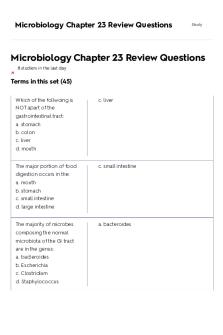Chapter 23 Sample Questions PDF

| Title | Chapter 23 Sample Questions |
|---|---|
| Course | The Solar System |
| Institution | Indiana University - Purdue University Indianapolis |
| Pages | 2 |
| File Size | 43.5 KB |
| File Type | |
| Total Downloads | 16 |
| Total Views | 215 |
Summary
Summery review questions from AST-A100 The Solar System Chapter 23...
Description
Chapter 23: Kuiper Belt and TNOs (Pluto) Summary Review Questions What is a reason Pluto isn't a planet? It is too small Which of the following about Pluto is true? It's surface is very reflective, it is one of the largest known TNOs, and it has an atmosphere of mostly nitrogen What is the biggest known TNO? Pluto is the biggest known TNO! What object in the Kuiper belt has the most interesting orbit known to date? Sedna How many known moons does Pluto have? 5 moons Why doesn't Pluto hit Neptune? Neptune is at least 90 degrees away when orbits cross How much do we know about objects in the Kuiper Belt? We know some of the objects in the Kuiper Belt and that there are many more objects undiscovered What is the orbital period of Sedna? 12000 years Why is Pluto's atmosphere getting thicker? Cryovolcanoes What is a TNO? Trans-Neptunian Object How Charon came to be a mystery, but what is thought to be a reason for its creation since its tides are locked with Pluto? It might have been made by colliding with Pluto. Which direction does Pluto rotate? Backwards Which moon belongs to Eris? Dysnomia
The Kuiper Belt is located where? Beyond Neptune's orbit Studying TNOs allows us to see what the solar system was like 4.5 billion years ago. Why? TNO's have not changed since the formation of the solar system which allows us to study their composition and determine the early materials of the universe. What must Neptune and Pluto both have in order to have a stable orbit? Both must have the same precession rate or else Pluto may get tossed out of our solar system by Neptune. What is Pluto's mass compared to Earth's? 0.22% of Earth's mass. Pluto has the same orbital period as what other objects? Plutinos If TNOs fall onto a plane, their plane seems to differ from the Ecliptic plane by how many degrees? 2-6 degrees Which of Pluto's moons are tidally locked to Pluto? Sharon What range does the Classical Region cover? The Classical Region covers 42 AU to 47 AU What is all the same between Pluto or Plutinos? Same orbital period How many moons does Pluto have? 5 moons What is the average distance of Plutinos from the sun? 39.8 AU What is the largest known TNO? Pluto How is Pluto's mass compared with the Earth's mass? Pluto is 0.22% of the Earth's mass How is Pluto's atmosphere changing? It is becoming thicker because of cryovolcanoes...
Similar Free PDFs

Chapter 23 Sample Questions
- 2 Pages

23 IWCF SO Sample Questions
- 6 Pages

Chapter 23 Review Questions
- 23 Pages

Chapter 6 Sample Questions
- 2 Pages

Chapter 11 Sample Questions
- 10 Pages

Chapter 16 Sample Questions
- 6 Pages

Chapter-2 - Exam sample Questions
- 34 Pages

Chapter 23
- 20 Pages

Chapter 23 - Lecture notes 23
- 8 Pages

Sample Questions
- 9 Pages

Sample Questions
- 42 Pages

Sample Questions
- 3 Pages
Popular Institutions
- Tinajero National High School - Annex
- Politeknik Caltex Riau
- Yokohama City University
- SGT University
- University of Al-Qadisiyah
- Divine Word College of Vigan
- Techniek College Rotterdam
- Universidade de Santiago
- Universiti Teknologi MARA Cawangan Johor Kampus Pasir Gudang
- Poltekkes Kemenkes Yogyakarta
- Baguio City National High School
- Colegio san marcos
- preparatoria uno
- Centro de Bachillerato Tecnológico Industrial y de Servicios No. 107
- Dalian Maritime University
- Quang Trung Secondary School
- Colegio Tecnológico en Informática
- Corporación Regional de Educación Superior
- Grupo CEDVA
- Dar Al Uloom University
- Centro de Estudios Preuniversitarios de la Universidad Nacional de Ingeniería
- 上智大学
- Aakash International School, Nuna Majara
- San Felipe Neri Catholic School
- Kang Chiao International School - New Taipei City
- Misamis Occidental National High School
- Institución Educativa Escuela Normal Juan Ladrilleros
- Kolehiyo ng Pantukan
- Batanes State College
- Instituto Continental
- Sekolah Menengah Kejuruan Kesehatan Kaltara (Tarakan)
- Colegio de La Inmaculada Concepcion - Cebu



